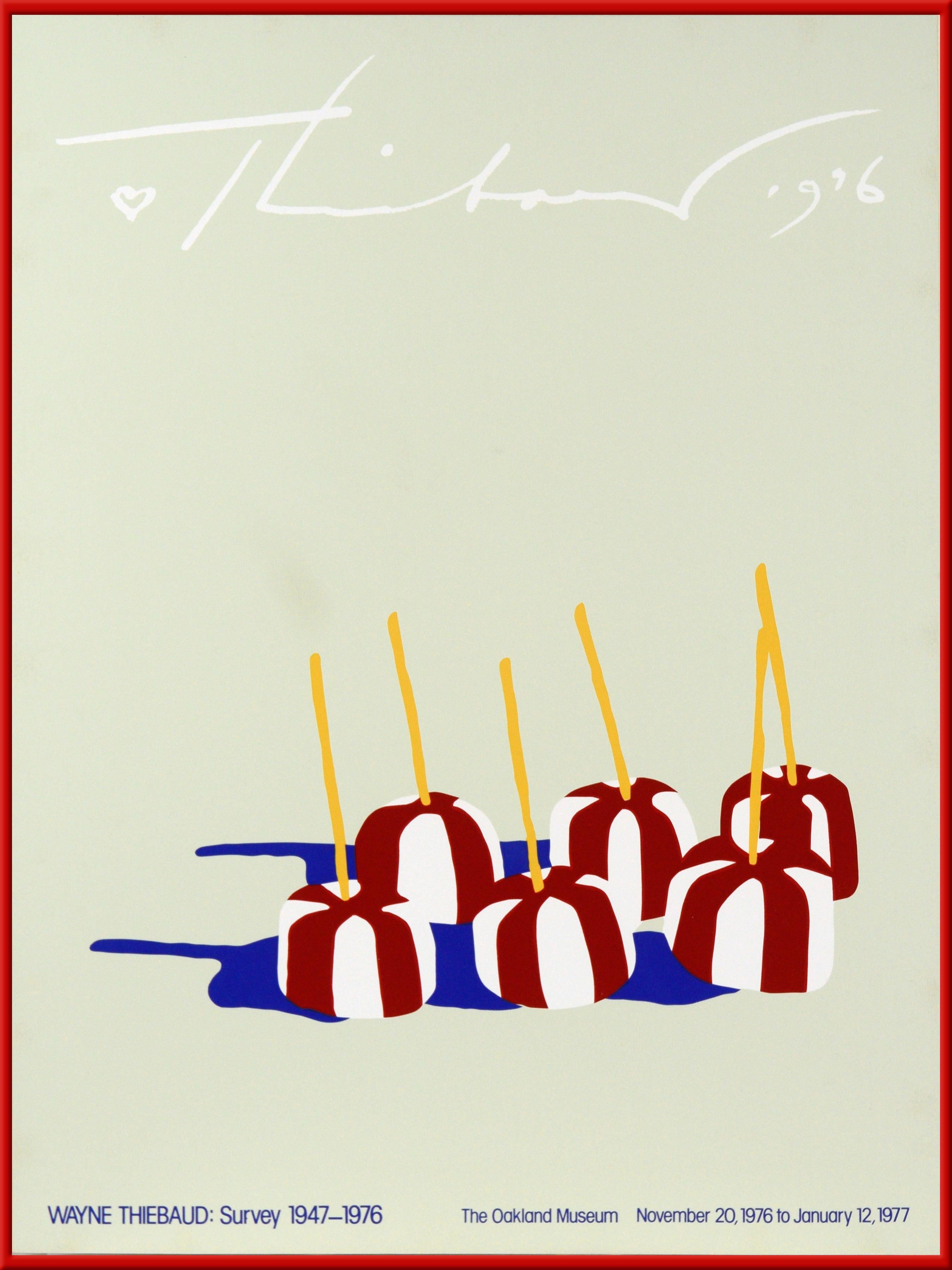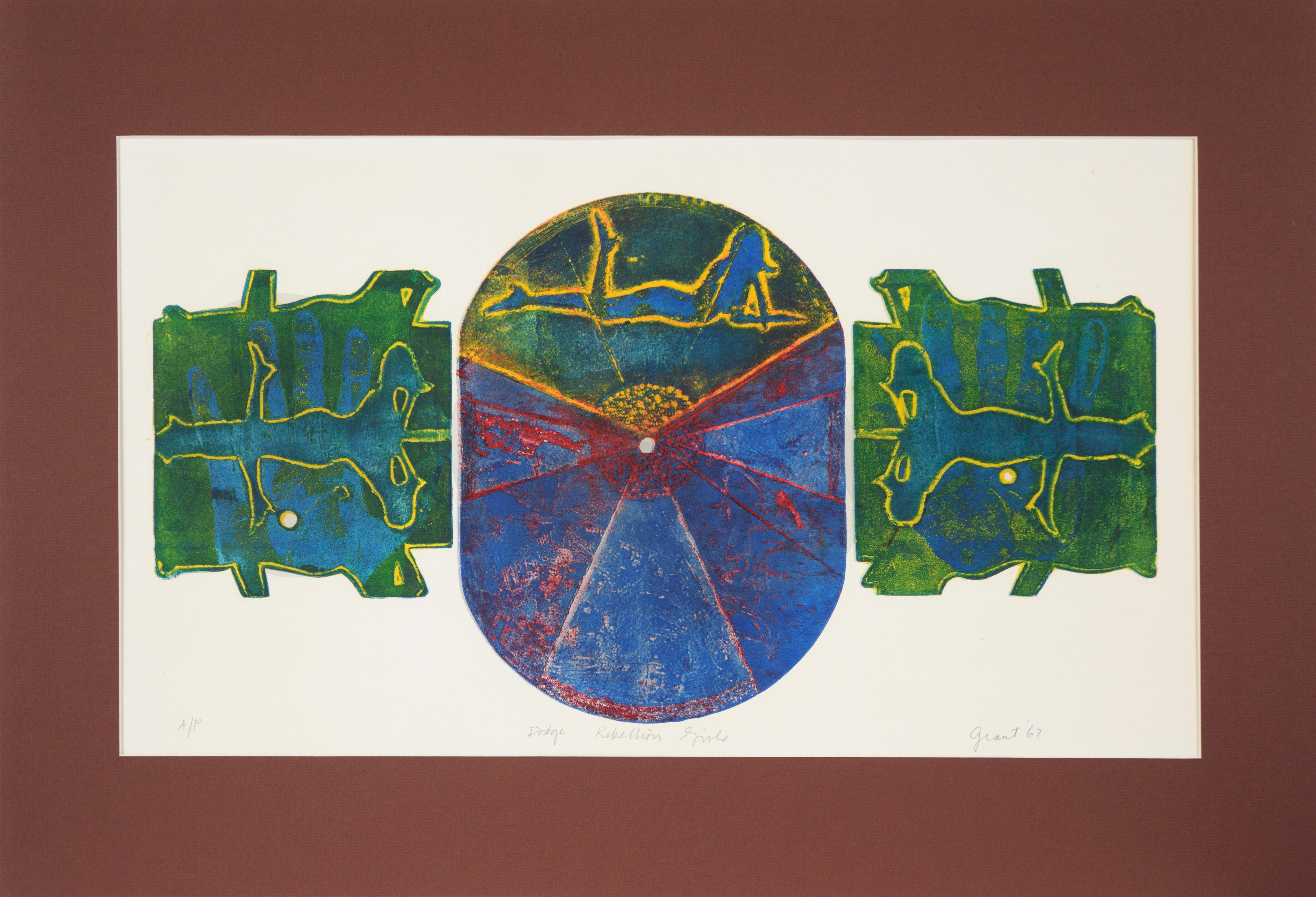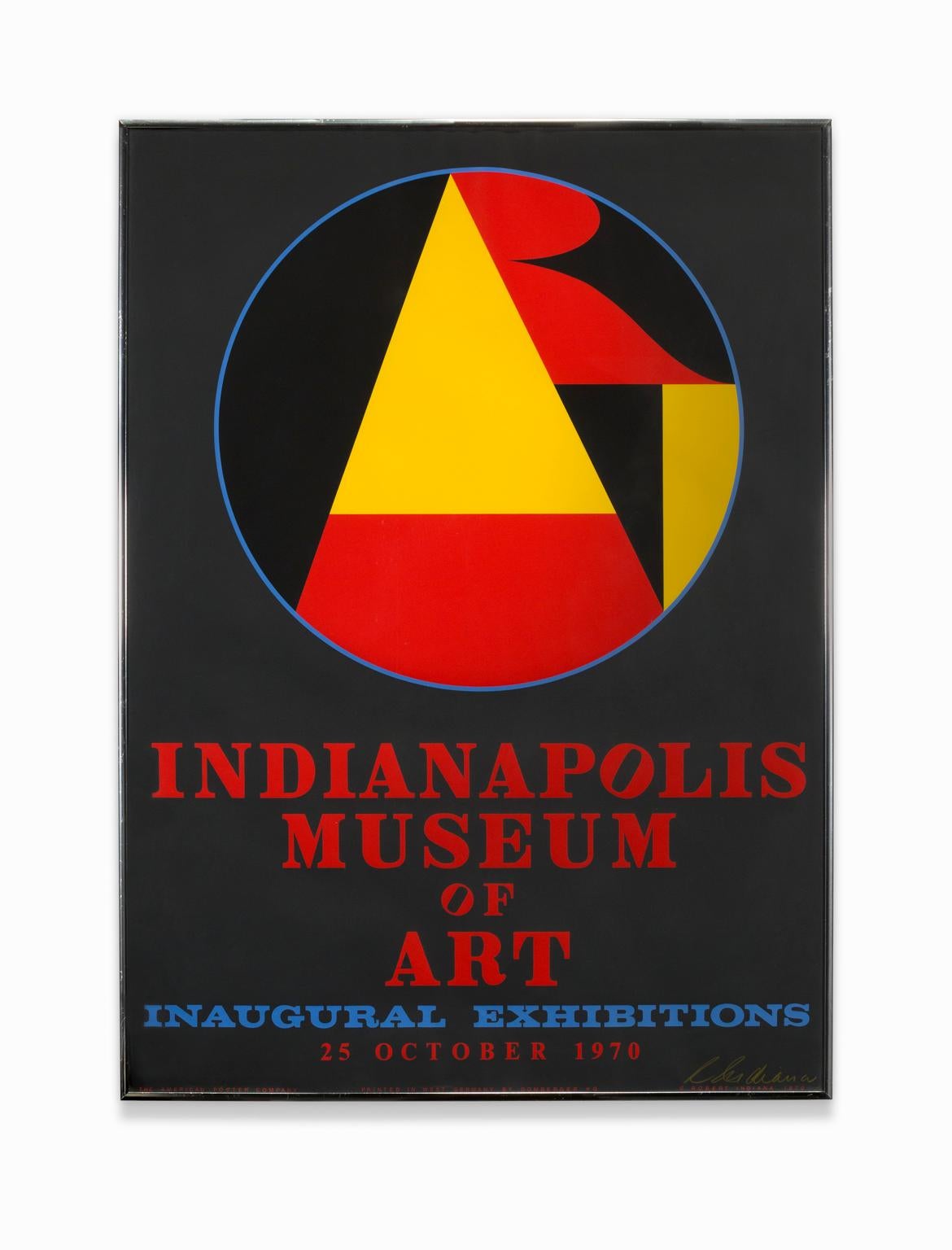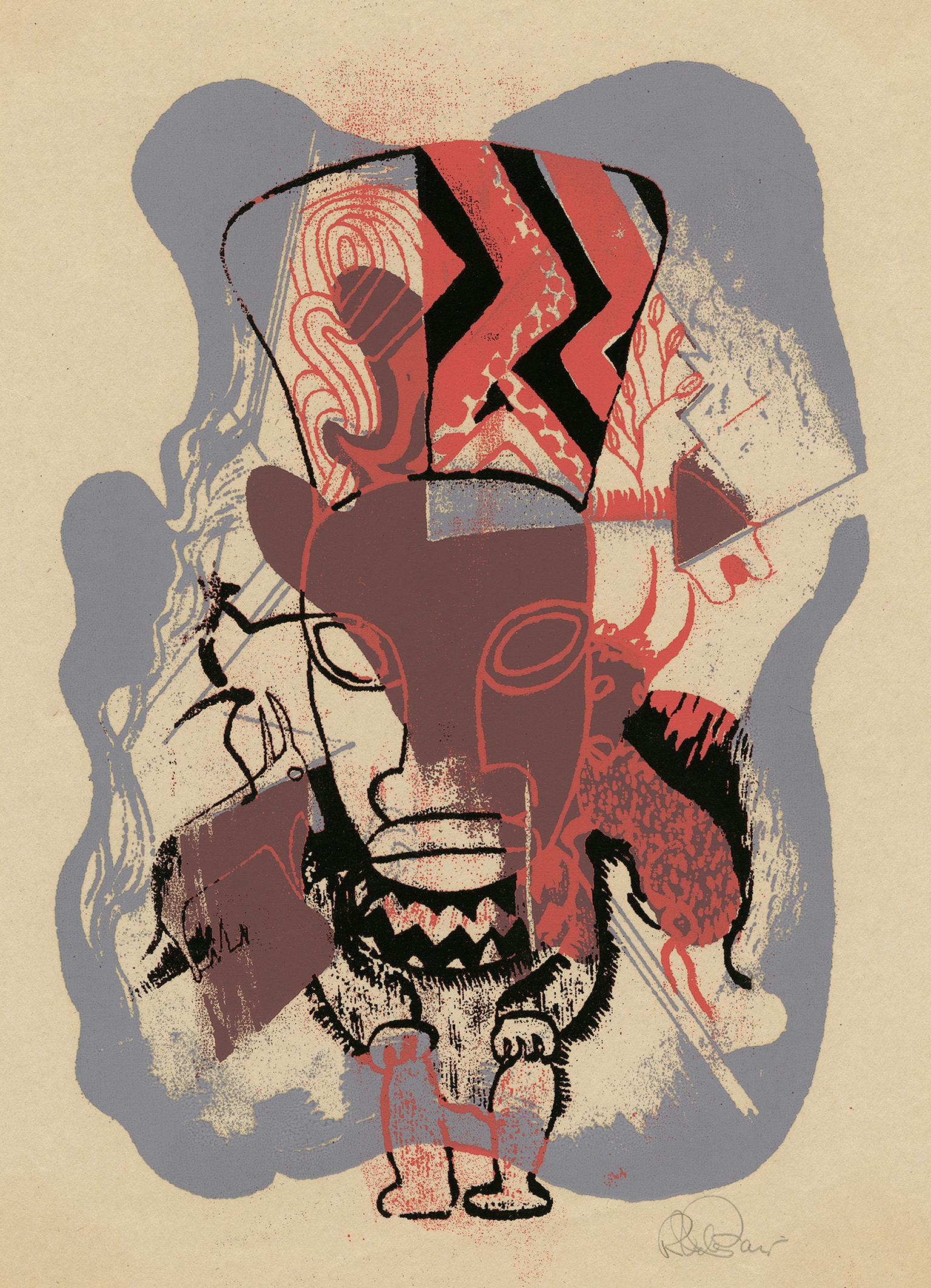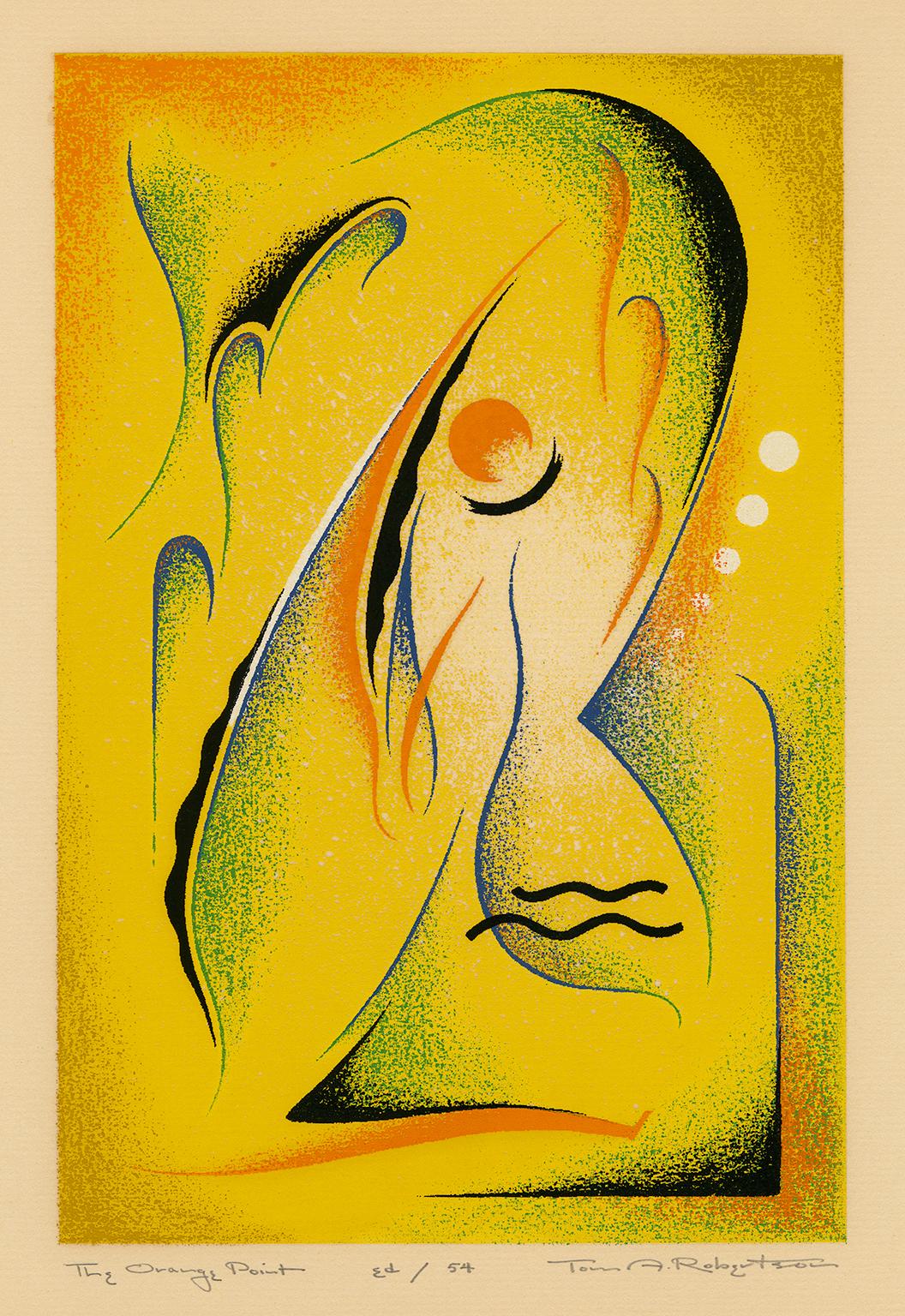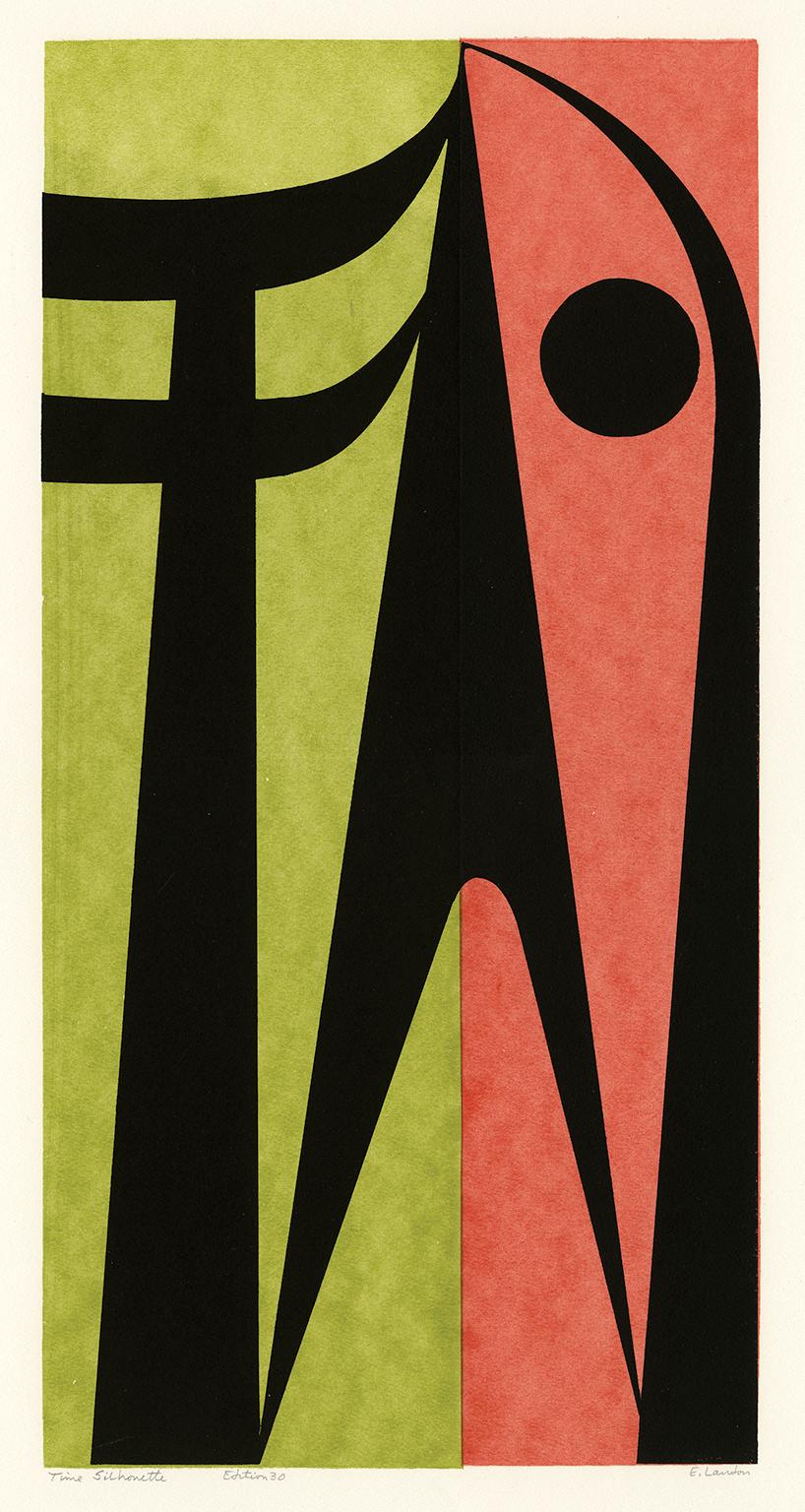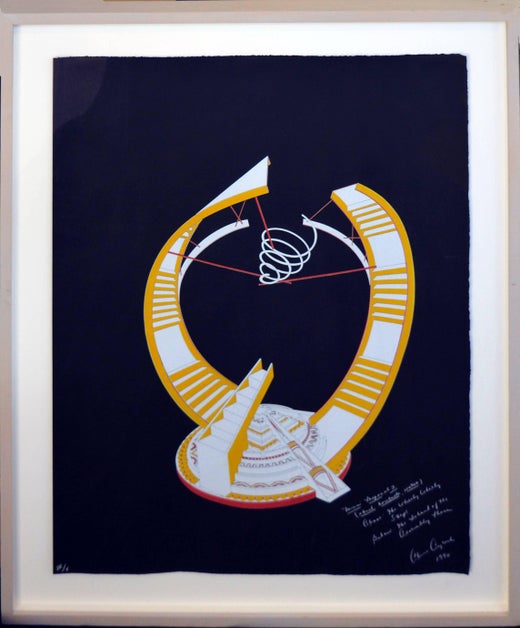Items Similar to Vintage Silkscreen Abstract -- The Wheely Whirly Steps
Want more images or videos?
Request additional images or videos from the seller
1 of 10
Alice AycockVintage Silkscreen Abstract -- The Wheely Whirly Steps1990
1990
About the Item
Expressive vintage silkscreen on black paper by Alice Aycock (American, 20th Century). Hand signed and dated "Alice Aycock 1990" with hand written description in conte crayon, "Above: The Wheely Whirly Steps; Below: Island of Assembly Place, edition: III/X,. " Image; 29"H x 22"W.
This piece is indicative of her early works which were site-specific structures, constructed of wood, stone, and earth, that drew heavily on childhood memories but were also rich with allusions to ancient history and architecture.
Biography from the National Gallery of Art: From childhood, Alice Aycock aspired to an artistic life. Inspired by stories told by her grandmother, which she later learned had their source in Gulliver's Travels, Aycock thought at first she would like to be a writer, but her interests shifted to the visual arts before she was twenty. Her sculptural-architectural sensibility was undoubtedly encouraged by her father, a construction engineer. As a child she watched him design and construct a scale model of a house he then built. Aycock's mother was especially supportive of her daughter's career; and one of the artist's first site pieces, Low Building with Dirt Roof (for Mary) (1973), was built with her mother's help on family property near New Kingston, Pennsylvania.
Aycock went to Douglass College in New Brunswick, New Jersey (B.A. 1968), then moved to New York and attended Hunter College (M.A. 1971), where Robert Morris was her teacher and adviser. She traveled intermittently, visiting sites in the American Southwest (Great Kivas), Greece and Turkey (Knossos, Epidaurus, Mycenaea), England and Mexico (Aztec temple at Malinaleo). Her Master's thesis, "An Incomplete Examination of the Highway Network/User/Perceiver Systems," was inspired in part by the underground passageways of the Mycenaean tholos tombs and the labyrinthine corridors of the ancient ruins at Knossos.
Aycock's early works were site-specific structures, constructed of wood, stone, and earth, that drew heavily on childhood memories but were also rich with allusions to ancient history and architecture. In the late 1970s her sources expanded to include literary references, often accompanied by cryptic, elusive texts. During the 1980s the work incorporated steel and other components evoking industry, which reflected her investigations into the power and poetry of the machine and the mystery of metaphysical forces.
In addition to her work at Graphicstudio, Aycock has also worked at Tandem Press at the University of Wisconsin-Madison. She has produced screenprints in Chicago with John W. Roberts, and at Ohio University. A sculpture edition, Celestial Alphabet (1983), was published by Multiples, Inc., New York. She has been visiting artist at various institutions, including the University of South Florida, Hunter College, Williams Colleges, Rhode Island School of Design, Princeton University, and the San Francisco Art Institute.
Aycock has created installations throughout the world, including Israel, Germany, The Netherlands, Italy, Switzerland, and Japan, and at numerous locations in the United States, including the Museum of Modern Art, New York (1977), the San Francisco Art Institute (1979), Museum of Contemporary Art, Chicago (1983), Sheldon Memorial Art Gallery, Lincoln, Nebraska (1985), State University of New York, Buffalo (1988), Altantic Arts Center, New Smyrna Beach, Florida (1989), and the Storm King Art Center, Mountainville, New York (1990). In 1983 a retrospective exhibition was organized by the Württembergischer Kunstverein and traveled in Germany, The Netherlands, and Switzerland. (Fine/Corlett 1991, 145)
- Creator:Alice Aycock (1946, American)
- Creation Year:1990
- Dimensions:Height: 34.5 in (87.63 cm)Width: 27 in (68.58 cm)Depth: 2 in (5.08 cm)
- Medium:
- Movement & Style:
- Period:
- Condition:
- Gallery Location:Soquel, CA
- Reference Number:
Alice Aycock
Alice Aycock studied in the late 1960s under minimalist pioneer Robert Morris, and soon thereafter began working on large-scale sculptures in wood and stone. In the 1980s, she began using steel and produced massive installations that challenged ideas of industrial aesthetics. She recently made headlines for “Paper Chase,” her series of monumental, ribbon-esque pieces along Park Avenue in Manhattan. Her steel works often appear to have transcended the laws of gravity, floating like tops above the otherwise-mundane grounds of public spaces and institutions. Aycock’s work breathes life into artificial environments, bringing playful shifts of perception wherever they are installed.
About the Seller
4.9
Platinum Seller
These expertly vetted sellers are 1stDibs' most experienced sellers and are rated highest by our customers.
Established in 1986
1stDibs seller since 2014
2,548 sales on 1stDibs
Typical response time: <1 hour
- ShippingRetrieving quote...Ships From: Soquel, CA
- Return PolicyA return for this item may be initiated within 14 days of delivery.
More From This SellerView All
- "Wayne Thiebaud: Survey 1947-1976" Oakland Museum Show PosterBy (After) Wayne ThiebaudLocated in Soquel, CA"Wayne Thiebaud: Survey 1947-1976" Show Poster from the Oakland Museum 1976-1977 Silkscreen poster from the Oakland Museum 1976-1977 show "Wayne Thiebaud: Survey 1947-1976" with a printing of an original drawing (Six Candied Apples...Category
1970s American Modern Abstract Prints
MaterialsPaper, Screen
- "Dodge Rebellion Girls" - 1967 Original Silkscreen on Paper Artists ProofBy Marc Foster GrantLocated in Soquel, CA"Dodge Rebellion Girls" - 1967 Silkscreen on Paper 1967 color silkscreen depicting the Dodge Rebellion Girls by Marc Foster Grant (American, b. 1947). A silhouette of the 'dodge gi...Category
1960s American Modern Figurative Prints
MaterialsPaper, Ink, Screen
- Portrait of Modern Man - Multilayer Woodblock in Ink on PaperLocated in Soquel, CAPortrait of Anger - Multilayer Woodblock in Ink on Paper Bold and saturated woodblock print of a screaming man by Michael Dow (American, 20th Century). The man is centered in this m...Category
1990s American Modern Figurative Prints
MaterialsPaper, Ink, Woodcut
- Gerry Mulligan, Baritone Sax - Rare Signed Figurative Lithograph in Ink on PaperLocated in Soquel, CAGerry Mulligan, Baritone Sax - Rare Signed Figurative Lithograph in Ink on Paper Bold lithograph by Eugene Hawkins (American, b. 1933). Gerry Mulligan sits on a stool holding his ba...Category
1960s American Modern Figurative Prints
MaterialsPaper, Ink, Lithograph
- Geometric Woman's Portrait - Rare Signed Graphite Drawing on Paper 1962Located in Soquel, CAGeometric Woman's Portrait - Rare Signed Graphite Drawing on Paper 1962 Beautiful, soft original drawing by Eugene Hawkins (American, b. 1933). A realistic depiction of a short-haired woman, her large lips parted into a soft smile. She's surrounded in geometric shapes offering a wonderful juxtaposition to the natural curves of her face and hair. Signed in pencil, "Eugene Hawkins '62" Presented in a new black mat. Mat size: 20"H x 16"W Paper size: 18.5"H x 14.5"W Eugene Hawkins (American, b. 1933) is a BIPOC artist known for his detailed portraiture and printmaking. He is listed in Who Was Who in American Art, 1564-1975, and his work was exhibited in the Whitney Museum of American Art. He spent the majority of his life working and exhibiting in Southern California. His work frequently touches upon socio-political subjects, making strong statements about the world. The California African American Museum features Eugene Hawkins's work in the Permanent Collection. Exhibition: 2017 Paperworks: Selections from the Permanent Collection focuses on works on paper produced from 1950-2000 and includes figurative, impressionistic, and abstract styles. The exhibition showcases the radically diverse range of works on paper created by African American and other artists over the last two centuries, and includes drawings, prints, paintings, and collages by Edward Mitchell Bannister...Category
1960s American Modern Figurative Prints
MaterialsGraphite, Paper
- "Henry S. Miller" Lithograph in Ink on Paper, #3 of 8Located in Soquel, CA"Henry S. Miller" Lithograph in Ink on Paper, #3 of 8 Surrealist lithograph by Stephen Tracy White (American, 1947-2005). A figure in the lower right corner is partially enclosed by a red rectangle. Biomorphic shapes are flowing out of the rectangle, stretching across the composition. The shapes are rendered with intricate linework and soft green shading. Numbered, titled, signed, and dated along the bottom: 3/8 Henry S. Miller S. Tracy White 1969/April Tag on verso from Lee Nordness Galleries, New York Presented in a silver aluminum frame. Shipped without glass. Frame size: 26.5"H x 36.25"W Image size: 23.5"H x 34.25"W Stephen Tracy White (American, 1947-2005) was born in Bronwood, Georgia. They studied at the University of New Mexico, earning a Bachelor of Fine Arts in Art in 1969. They worked at the Tamarind Lithography Workshop, printing pieces by William Crutchfield...Category
1960s American Modern Portrait Prints
MaterialsPaper, Ink, Lithograph
You May Also Like
- "Indianapolis Museum of Art Inaugural Exhibitions", Color Silkscreen, SignedBy Robert IndianaLocated in Detroit, MI"Indianapolis Museum of Art Inaugural Exhibitions", 25 October 1970, is an eye popping large bold colorful geometric abstract silk screen. It is signed on the lower right. Robert Indiana, one of the preeminent figures in American art since the 1960s, played a central role in the development of assemblage art, hard-edge painting, Pop art, Neo-Dada, American Modernism and Modern Art. A self-proclaimed “American painter of signs,” Indiana created a highly original body of work that explores American identity, personal history, and the power of abstraction and language, establishing an important legacy that resonates in the work of many contemporary artists such as Andy Warhol, Keith Haring, Roy Lectenstein, David Hockney, Romero Britto, Richard Hamilton and Robert Rauschenberg who make the written word a central element of their oeuvre. Robert Indiana was born Robert Clark in New Castle, Indiana on September 13, 1928. Adopted as an infant, he spent his childhood moving frequently throughout his namesake state. At 14 he moved to Indianapolis in order to attend Arsenal Technical High School, known for its strong arts curriculum. After graduating he spent three years in the U.S. Air Force and then studied at the Art Institute of Chicago, the Skowhegan School of Sculpture and Painting in Maine, and the Edinburgh College of Art in Scotland. In 1956, two years after moving to New York, Indiana met Ellsworth Kelly, and upon his recommendation took up residence in Coenties Slip, where a community of artists that would come to include Kelly, Agnes Martin, James Rosenquist, and Jack Youngerman had studios. Indiana, like some of his fellow artists, scavenged the area’s abandoned warehouses for materials, creating sculptural assemblages from old wooden beams, rusted metal wheels, and other remnants of the shipping trade that had thrived in Coenties Slip. The discovery of 19th century brass stencils led to the incorporation of brightly colored numbers and short emotionally charged words onto these sculptures as well as canvases, and became the basis of his new painterly vocabulary. Although acknowledged as a leader of Pop, Indiana distinguished himself from his Pop peers by addressing important social and political issues and incorporating profound historical and literary references into his works. In 1964 Indiana accepted Philip Johnson’s invitation to design a new work for the New York State Pavilion at the New York World’s Fair, creating a 20-foot EAT sign...Category
1970s American Modern Abstract Prints
MaterialsPaper, Ink, Screen
- 'African Idol' — 1930s American ModernismBy Robert Vale FaroLocated in Myrtle Beach, SCRobert Vale Faro, untitled (African Idol), serigraph, c. 1940, edition 6. Signed in pencil. A fine impression, with fresh colors, on buff wove paper; the full sheet with margins(5/8 to 1 3/8 inches), in excellent condition. Very rare. Matted to museum standards, unframed. Image size 8 3/4 x 6 inches (222 x 152 mm); sheet size 11 x 7 1/2 inches (279 x 192 mm). ABOUT THE ARTIST Robert Vale Faro (1902-1988) was a well-known modernist architect and artist associated with the Chicago Bauhaus. He received his degree in architecture and design from the Armour Institute in Chicago and worked at L'Ecole des Beaux-Arts, Paris, from 1924-27, where he was influenced by Harry Kurt Bieg and Le Corbusier. Upon his return to Chicago, Faro worked with the important modernist Chicago architects George and William Keck under Louis Sullivan. Faro founded the avant-garde printmaking group Vanguard in 1945. The group counted Atelier 17 artists Stanley William Hayter, Sue Fuller, and Anne Ryan as New York members and Francine...Category
1940s American Modern Abstract Prints
MaterialsScreen
- 'The Orange Point' — Mid-Century ModernismBy Thomas A. RobertsonLocated in Myrtle Beach, SC'The Orange Point', color serigraph, edition 54, c. 1940. Signed, titled, and annotated 'Ed/54' in pencil. A fine impression, with fresh colors, on buff wove paper; the full sheet wi...Category
1940s American Modern Abstract Prints
MaterialsScreen
- Time Silhouette —Mid-Century ModernBy Edward August LandonLocated in Myrtle Beach, SCEdward Landon, 'Time Silhouette', color serigraph, 1969, edition 30, Ryan 201. Signed, titled, and annotated 'Edition 30' in pencil. A fine impression, with fresh colors, on cream wo...Category
Mid-20th Century American Modern Abstract Prints
MaterialsScreen
- 'Flyable Objects Identified' —Mid-Century ModernBy Edward August LandonLocated in Myrtle Beach, SCEdward Landon, 'Flyable Objects Identified', color serigraph, 1969, edition 30, Ryan 83. Signed, titled, and annotated 'Edition 30' in pencil. A fine impression, with fresh colors, o...Category
Mid-20th Century American Modern Abstract Prints
MaterialsScreen
- 'Salient in February' — Mid-Century AbstractionBy Edward August LandonLocated in Myrtle Beach, SCEdward Landon, 'Salient in February', color serigraph, 1945, edition 25, Ryan 166. Signed in pencil. Titled, dated, and annotated 'ED. 40' in pencil. A fine impression, with fresh colors, on cream, wove paper; with full margins (1 3/4 to 2 5/8 inches, top sheet edge deckle); in excellent condition. Image size 9 x 11 inches; sheet size 12 3/4 x 16 inches. Matted to museum standards, unframed. ABOUT THE ARTIST Born in Hartford, Connecticut, Edward Landon dropped out of high school to study art at the Hartford Art School. In 1930 and 1931, he was a student of Jean Charlot at the Art Students League in New York, after which he traveled to Mexico to study privately for a year with Carlos Merida. In 1933 he settled near Springfield, Massachusetts, painted murals in the local trade school, and exhibited with the Springfield Art League. His painting 'Memorial Day' won first prize at the fifteenth annual exhibition of the League at the Springfield Museum of Fine Arts. Landon became an active member of the Artists Union of Western Massachusetts, serving as president from 1934-1938. Landon acquired Anthony Velonis’s instructional pamphlet on the technique of serigraphy in the late 1930s. With colleagues Phillip Hicken, Donald Reichert, and Pauline Stiriss, he began experimenting with screen printing techniques. The artists' groundbreaking work in screen printing as a fine art medium was the subject of the group’s landmark exhibition at the Springfield Museum of Fine Arts in 1940. Landon became one of the founding members of the National Serigraph Society and served as editor of its publication, 'Serigraph Quarterly,' in the late 1940s and as its president in 1952 and 1953. The Norlyst Gallery in Manhattan held a one-person show of his prints in 1945. Awarded a Fulbright Fellowship in 1950, Landon traveled to Norway, where he researched the history of local artistic traditions and produced the book 'Scandinavian Design: Picture and Rune Stones...Category
Mid-20th Century American Modern Abstract Prints
MaterialsScreen
Recently Viewed
View AllMore Ways To Browse
Vintage Japanese Print
Mother And Daughters Print
Stone Steps
Her First Steps
Wood Steps
Mexican Aztec
Mexico Aztec
Vintage Turkish Prints
Greek Island Prints
Vintage Celestial Art
Mother Mary And Child
Mary And Child Sculpture
Japanese Screen 1970s
Mother And Child Stone Sculpture
1988 Vintage Watch
1971 Vintage Watch
Stone Mary Sculpture
1977 Vintage Watch
